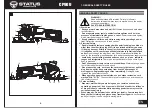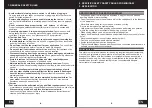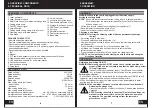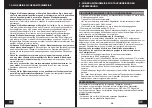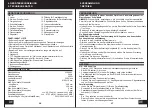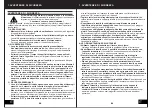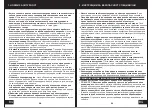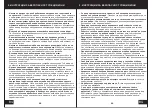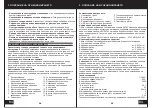
EN
8
7. OPERATION
Setting the guide fence
• Release the lock screw for guide fence (11) on the base plate (18)
• Set the guide fence in the guide fence slot (10).
• Set a desired width and re tighten the lock screw for the guide fence (11).
Laser line generator
Warnings! Do not stare directly at the laser beam, do not deliberately aim the
beam at personnel and ensure that it is not directed towards the
eye of a person for longer than 0.25s.
When you make the line of the cut on the work piece,
the laser line generator can help you get better alignment.
• Turn on: Press the laser generator switch (2) to “I” position, the laser generator (1)
works. Line the laser up with cutting marks on your workpiece.
• Turn off: Press the switch (2) to “O” position.
• Make sure line of the cut is on the work piece.
• Adjust the depth of cut as required.
• Plug in the machine and start the motor.
• When the blade is at its maximum speed (approximately 5 seconds),
place the saw on the work piece .
• Switch on the laser generator (1) from the laser aperture using the laser generator
switch(2).
• Align the beam with the mark on the work piece and slowly push the saw forward
using both hands, keeping the red light beam on the mark.
• Switch off the laser beam when completion of the cut.
Line following
• A V-shaped notch at the front of base plate and a protruding pointer at the rear
(18) allow user to accurately align the cutting mark on the workpiece.
Dust extraction
The mini circular saw is a powerful tool capable of producing a large amount of dust.
As the tool has a fully enclosed blade, forced dust extraction is particularly efficient.
Forced dust extraction should be used for all but small trimming jobs.
• Push the dust extraction hose on to the dust extraction nozzle (17).
• Connect a vacuum device approved for the extraction of sawdust and splinters to
the dust extraction hose.
CUTTING
WARNING! Before using the machine, need to check the function of
removable protective cover (12) can be used properly.
Always cut in a forward direction. Never draw the tool
backwards. If you are a novice user, practice by cutting thin wood
until proficient.
• Check the specifications to ensure the suitability of the material to be cut.
• Fit the correct blade ensuring it is sharp and not damaged.
9
EN
7. OPERATION
• Set the depth of cut. (See “Setting the cutting depth”)
• Place the material to be cut onto a flat surface such as a workbench, table or floor.
Use a piece of scrap material underneath if you do not wish to damage the work
surface.
• Plug into mains supply.
• Grasp the tool firmly (See “Holding & switching ON/OFF”) and rest its metal base
plate onto the surface to be cut. Ensure that the rear half of the base plate
overhangs the work surface. Do not plunge the blade into the material.
• Switch on the tool and wait for a moment for the blade to run up to speed.
Next, depress the safety lock button (3) and plunge the blade into the material
slowly and gently, but firmly. Then push the tool forwards along the line to be cut.
If necessary, switch on the laser generator (1).
•
NOTE:
Never draw the tool backwards.
• Very little force should be used to feed the tool along the cut. Excess force will
cause operator fatigue and excessive wear to the blade and tool. Excess force is
also likely to cause the temperature cut-out to trip, resulting in delays.
• Ensure that the base plate is always held flat on the material being cut.
This is particularly important at the start or finish of a cut or if thin strips are being
cut where the base plate is not fully supported.
• Once the cut has been finished, lift the tool from the work surface before switching
off. If a lot of dust has been created, keep switched on for a few seconds extra to
allow the dust to clear from within the tool.
CUT-OUTS
Plunge cutting may not be possible in some hard materials.
• Choose a suitable saw blade for hard materials and change to it. Set the depth of
cut (See “Setting the Cutting Depth” section), plug in the mains supply and then
place the metal base plate (18) onto the work surface. Ensure that the front
indication mark on the base plate aligns with the start line (See “Line Following”).
• Switch on the tool and wait for a moment for the blade to run up to speed.
Next, plunge the blade into the material slowly and gently, but firmly. Then push
the tool forwards along the line to be cut. (Never draw the tool backwards)
• Once the finish line has been reached, lift the tool from the work surface before
switching off. If a lot of dust has been created, keep switched on for a few seconds
extra to allow the dust to clear from within the tool.
Cutting out tips:
• If the cut is to be covered, for example by a vent cover, the corners can be
overlapped to ensure that the waste material is completely detached.
• If the cut out is to be seen, do not overlap the corners. In this circumstance, as the
cutting blade is circular, the waste material will not be fully detached. The corners
will therefore, require finishing with a knife. If the material is thin and the back
surface unimportant, the waste material can just be pushed out.
• Where there is access to the back surface of the material to be cut, the cut out
can be marked out with an over cutting allowance.


